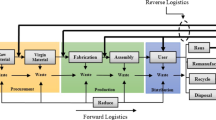Abstract
This study seeks to plan and evaluate the cost of the logistics in manufacturing tetra duplex board using prime grade and recycled materials. The real-world data for this study is obtained from one of the largest paper and board industries in Asia. The bi-objective problem is formulated by developing a mixed integer linear programming (MILP) model considering the constraints related to raw material supplies, processing, and storage. The metaheuristic optimization techniques are applied based on the concept of epsilon dominance to balance the conflicting objectives to counter the complex problem in the real world of transportation for the ease of the decision-makers to make the best-informed decisions in the selection of raw material. The investigation results indicate that the cost of prime-grade material in the tetra duplex board supply chain is 71 percent higher than recycled fiber. Furthermore, this study can be extended by evaluating the environmental aspects of prime and recycled-grade transportation. Moreover, the logistics of the prime grade can further be narrowed down by investigating it in various modes of transportation such as highways, waterways, rail, and air.






Similar content being viewed by others
Data Availability
Some or all data, models, or code that support the findings of this study are available from the corresponding author upon reasonable request.
Notes
\({\mathrm{D}\mathrm{C}}_{\mathrm{s}\mathrm{p}\mathrm{w}}\): Transport cost per vehicle (w = 1) from vendor s to move the items to processor p.
\({\mathrm{D}\mathrm{C}}_{\mathrm{r}\mathrm{p}\mathrm{w}}\): Transport cost per vehicle (w = 2) for processor r to move wasted material to processor p.
References
Bekta̧s T, Chouman M, Crainic TG (2010) Lagrangean-based decomposition algorithms for multicommodity network design problems with penalized constraints. In: Networks. pp 171–180
Erwin K, Engelbrecht A (2023) Meta-heuristics for portfolio optimization. Soft Comput. https://doi.org/10.1007/s00500-023-08177-x
Eskandarpour M, Nikbakhsh E, Zegordi SH (2014) Variable neighborhood search for the bi-objective post-sales network design problem: A fitness landscape analysis approach. Comput Oper Res 52:300–314. https://doi.org/10.1016/j.cor.2013.06.002
FAOSTAT (2019) Forest production and trade. https://www.fao.org/faostat/en/#data. Accessed 17 Apr 2022
Fattahi M (2020) A data-driven approach for supply chain network design under uncertainty with consideration of social concerns. Ann Oper Res 288:265–284. https://doi.org/10.1007/s10479-020-03532-9
Fattahi M, Govindan K (2017) Integrated forward/reverse logistics network design under uncertainty with pricing for collection of used products. Ann Oper Res 253:193–225. https://doi.org/10.1007/s10479-016-2347-5
Fleischmann M, Bloemhof-Ruwaard JM, Dekker R et al (1997) Quantitative models for reverse logistics: A review. Eur J Oper Res 103:1–17. https://doi.org/10.1016/S0377-2217(97)00230-0
Fonseca MC, García-Sánchez Á, Ortega-Mier M, Saldanha-da-Gama F (2010) A stochastic bi-objective location model for strategic reverse logistics. TOP 18:158–184. https://doi.org/10.1007/s11750-009-0107-2
Fu R, (Patrick) Qiang Q, Ke K, Huang Z (2021) Closed-loop supply chain network with interaction of forward and reverse logistics. Sustain Prod Consum 27:737–752. https://doi.org/10.1016/j.spc.2021.01.037
Hasani A, Zegordi SH, Nikbakhsh E (2012) Robust closed-loop supply chain network design for perishable goods in agile manufacturing under uncertainty. Int J Prod Res 50:4649–4669. https://doi.org/10.1080/00207543.2011.625051
Holland JH (1975a) Adaptation in natural and artificial systems : an introductory analysis with applications to biology, control, and artificial intelligence. Ann Arbor Univ Michigan Press 1975 viii, p 183
Holland JH (1975b) Adaptation in Natural and Artificial Systems. Ann Arbor: University of Michigan Press. University of Michigan Press, Ann Arbor. MIT Press, 1992 - References - Scientific Research Publishing
Kilani Y (2010) Comparing the performance of the genetic and local search algorithms for solving the satisfiability problems. Appl Soft Comput J 10:198–207. https://doi.org/10.1016/j.asoc.2009.07.012
Krikke H (1998) Recovery strategies and reverse logistic network design. Tilburg University, Netherlands. https://pure.uvt.nl/ws/portalfiles/portal/1307833/recovery.pdf
Lee DH, Dong M (2009) Dynamic network design for reverse logistics operations under uncertainty. Transp Res Part E Logist Transp Rev 45:61–71. https://doi.org/10.1016/j.tre.2008.08.002
Li H, Song B, Tang X et al (2021) A multi-objective bat algorithm with a novel competitive mechanism and its application in controller tuning. Eng Appl Artif Intell 106. https://doi.org/10.1016/j.engappai.2021.104453
Liotta G, Stecca G, Kaihara T (2015) Optimisation of freight flows and sourcing in sustainable production and transportation networks. Int J Prod Econ 164:351–365. https://doi.org/10.1016/j.ijpe.2014.12.016
Malakooti B, Kim H, Sheikh S (2012) Bat intelligence search with application to multi-objective multiprocessor scheduling optimization. Int J Adv Manuf Technol 60:1071–1086. https://doi.org/10.1007/s00170-011-3649-z
Mansouri SA, Aktas E (2016) Minimizing Energy consumption and makespan in a two-machine flowshop scheduling problem. J Oper Res Soc 67:1382–1394. https://doi.org/10.1057/jors.2016.4
Michalewicz Z (1996) A Hierarchy of Evolution Programs. Genetic Algorithms + Data Structures = Evolution Programs. Springer, Berlin Heidelberg, pp 289–306
Miranda R, Bobu E, Grossmann H et al (2010) Factors influencing a higher use of recovered paper in the european paper industry. Cellul Chem Technol 44:419–430
National Logistics and Freight Policy (2020) State of Pakistan’s Freight and Logistics Sector. https://communication.gov.pk/SiteImage/Policy/NFLP%20Main%20Document%20(Final)%2013%20September%202020-converted.pdf
Pishvaee MS, Farahani RZ, Dullaert W (2010) A memetic algorithm for bi-objective integrated forward/reverse logistics network design. Comput Oper Res 37:1100–1112. https://doi.org/10.1016/j.cor.2009.09.018
Resat HG, Turkay M (2015) Design and operation of intermodal transportation network in the Marmara region of Turkey. Transp Res Part E Logist Transp Rev 83:16–33. https://doi.org/10.1016/j.tre.2015.08.006
Resat HG, Turkay M (2019) A bi-objective model for design and analysis of sustainable intermodal transportation systems: a case study of Turkey. Int J Prod Res 57:6146–6161. https://doi.org/10.1080/00207543.2019.1587187
Roghanian E, Pazhoheshfar P (2014) An optimization model for reverse logistics network under stochastic environment by using genetic algorithm. J Manuf Syst 33:348–356. https://doi.org/10.1016/j.jmsy.2014.02.007
Rushton A, Croucher P, Baker P (2014) The handbook of logistics and distribution management understanding the supply chain, 5th edn. Kogan Page, London, UK. https://industri.fatek.unpatti.ac.id/wp-content/uploads/2019/03/149-The-Handbook-of-Logistics-and-Distribution-Management-Understanding-the-Supply-Chain-Alan-Rushton-Phil-Croucher-Peter-Baker-Edisi-1-2014.pdf
Sadiqa A, Gulagi A, Bogdanov D et al (2022) Renewable energy in Pakistan: Paving the way towards a fully renewables-based energy system across the power, heat, transport and desalination sectors by 2050. IET Renew Power Gener 16:177–197. https://doi.org/10.1049/rpg2.12278
Sahebjamnia N, Fathollahi-Fard AM, Hajiaghaei-Keshteli M (2018) Sustainable tire closed-loop supply chain network design: Hybrid metaheuristic algorithms for large-scale networks. J Clean Prod 196:273–296. https://doi.org/10.1016/j.jclepro.2018.05.245
Shafiee Roudbari E, Fatemi Ghomi SMT, Sajadieh MS (2021) Reverse logistics network design for product reuse, remanufacturing, recycling and refurbishing under uncertainty. J Manuf Syst 60:473–486. https://doi.org/10.1016/j.jmsy.2021.06.012
Shehu A (2015) A Review of Evolutionary Algorithms for Computing Functional Conformations of Protein Molecules. 31–64. https://doi.org/10.1007/7653_2015_47
Shoukat R, Zhang X, Saeed A (2022) United Arab Emirates-Pakistan: the role of rail in green and economical intermodal and multimodal. Int J Shipp Transp Logist 15:382–406. https://doi.org/10.1504/ijstl.2022.126954
Shuang Y, Diabat A, Liao Y (2019) A stochastic reverse logistics production routing model with emissions control policy selection. Int J Prod Econ 213:201–216. https://doi.org/10.1016/j.ijpe.2019.03.006
Soner Kara S, Onut S (2010) A stochastic optimization approach for paper recycling reverse logistics network design under uncertainty. Int J Environ Sci Technol 7:717–730. https://doi.org/10.1007/bf03326181
Steadieseifi M, Dellaert NP, Nuijten W et al (2014) Multimodal freight transportation planning: A literature review. Eur J Oper Res 233:1–15. https://doi.org/10.1016/j.ejor.2013.06.055
Tautenhain CPS, Barbosa-Povoa AP, Nascimento MCV (2019) A multi-objective matheuristic for designing and planning sustainable supply chains. Comput Ind Eng 135:1203–1223. https://doi.org/10.1016/j.cie.2018.12.062
The World Bank (2018) The Logistics Performance Index and Its Indicators. https://openknowledge.worldbank.org/server/api/core/bitstreams/628a4f9d-7faa-54bf-97b0-f6080c6d46cd/content. Accessed 17 Jan 2022
Tibben-Lembke RS, Rogers DS (2002) Differences between forward and reverse logistics in a retail environment. Supply Chain Manag an Int J 7:271–282. https://doi.org/10.1108/13598540210447719/FULL/HTML
Trochu J, Chaabane A, Ouhimmou M (2019) A two-stage stochastic optimization model for reverse logistics network design under dynamic suppliers’ locations. Waste Manag 95:569–583. https://doi.org/10.1016/j.wasman.2019.06.012
Whittaker G, Confesor R, Griffith SM et al (2009) A hybrid genetic algorithm for multiobjective problems with activity analysis-based local search. Eur J Oper Res 193:195–203. https://doi.org/10.1016/j.ejor.2007.10.050
Yang XS (2011) Bat algorithm for multi-objective optimisation. Int J Bio-Inspired Comput 3:267–274. https://doi.org/10.1504/IJBIC.2011.042259
Zarbakhshnia N, Kannan D, Kiani Mavi R, Soleimani H (2020) A novel sustainable multi-objective optimization model for forward and reverse logistics system under demand uncertainty. Ann Oper Res 295:843–880. https://doi.org/10.1007/s10479-020-03744-z
Funding
The authors received no direct/indirect funding for this research.
Author information
Authors and Affiliations
Contributions
Rizwan Shoukat: Methodology, Software, Validation, Formal analysis, Visualization, Conceptualization, Writing – original draft, Conceptualization. Ayesha Saeed: Writing – review & editing, Software, Writing – original draft.
Corresponding author
Ethics declarations
Conflict of Interest
The authors declare no competing interests.
Additional information
Publisher's Note
Springer Nature remains neutral with regard to jurisdictional claims in published maps and institutional affiliations.
Appendix
Appendix
Rights and permissions
Springer Nature or its licensor (e.g. a society or other partner) holds exclusive rights to this article under a publishing agreement with the author(s) or other rightsholder(s); author self-archiving of the accepted manuscript version of this article is solely governed by the terms of such publishing agreement and applicable law.
About this article
Cite this article
Shoukat, R. How Recycled Grade is Economical? An Application of MILP and Evolutionary Algorithms in Intermodal Networks Under Uncertain Demand. Netw Spat Econ 24, 231–260 (2024). https://doi.org/10.1007/s11067-023-09613-z
Accepted:
Published:
Issue Date:
DOI: https://doi.org/10.1007/s11067-023-09613-z




